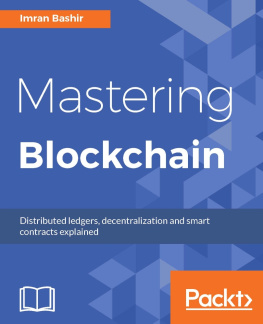Max Hooper - Blockchain Enabled Applications: Understand the Blockchain Ecosystem and How to Make it Work for You
Here you can read online Max Hooper - Blockchain Enabled Applications: Understand the Blockchain Ecosystem and How to Make it Work for You full text of the book (entire story) in english for free. Download pdf and epub, get meaning, cover and reviews about this ebook. year: 2017, publisher: Apress, genre: Home and family. Description of the work, (preface) as well as reviews are available. Best literature library LitArk.com created for fans of good reading and offers a wide selection of genres:
Romance novel
Science fiction
Adventure
Detective
Science
History
Home and family
Prose
Art
Politics
Computer
Non-fiction
Religion
Business
Children
Humor
Choose a favorite category and find really read worthwhile books. Enjoy immersion in the world of imagination, feel the emotions of the characters or learn something new for yourself, make an fascinating discovery.
- Book:Blockchain Enabled Applications: Understand the Blockchain Ecosystem and How to Make it Work for You
- Author:
- Publisher:Apress
- Genre:
- Year:2017
- Rating:4 / 5
- Favourites:Add to favourites
- Your mark:
Blockchain Enabled Applications: Understand the Blockchain Ecosystem and How to Make it Work for You: summary, description and annotation
We offer to read an annotation, description, summary or preface (depends on what the author of the book "Blockchain Enabled Applications: Understand the Blockchain Ecosystem and How to Make it Work for You" wrote himself). If you haven't found the necessary information about the book — write in the comments, we will try to find it.
Work with blockchain and understand its potential application beyond cryptocurrencies in the domains of healthcare, Internet of Things, finance, decentralized organizations, and open science. Featuring case studies and practical insights generated from a start-up spun off from the authors own lab, this book covers a unique mix of topics not found in others and offers insight into how to overcome real hurdles that arise as the market and consumers grow accustomed to blockchain based start-ups.
Youll start with a review of the historical origins of blockchain and explore the basic cryptography needed to make the blockchain work for Bitcoin. You will then learn about the technical advancements made in the surrounded ecosystem: the Ethereum virtual machine, Solidity, Colored Coins, the Hyperledger Project, Blockchain-as-a-service offered through IBM, Microsoft and more.This book looks at the consequences of machine-to-machine transactions using the blockchain socially, technologically, economically and politically. Blockchain Enabled Applications provides you with a clear perspective of the ecosystem that has developed around the blockchain and the various industries it has penetrated.
What Youll Learn
- Implement the code-base from Fabric and Sawtooth, two open source blockchain-efforts being developed under the Hyperledger Project
- Evaluate the benefits of integrating blockchain with emerging technologies, such as machine learning and artificial intelligence in the cloud
- Use the practical insights provided by the case studies to your own projects or start-up ideas
- Set up a development environment to compile and manage projects
Who This Book Is For
Developers who are interested in learning about the blockchain as a data-structure, the recent advancements being made and how to implement the code-base.
Decision makers within large corporations (product managers, directors or CIO level executives) interested in implementing the blockchain who need more practical insights and not just theory.
Max Hooper: author's other books
Who wrote Blockchain Enabled Applications: Understand the Blockchain Ecosystem and How to Make it Work for You? Find out the surname, the name of the author of the book and a list of all author's works by series.








![Bellaj Badr [Bellaj Badr] - Blockchain By Example](/uploads/posts/book/119701/thumbs/bellaj-badr-bellaj-badr-blockchain-by-example.jpg)
